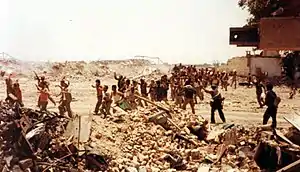Battle of Khorramshahr (1982)
The Second Battle of Khorramshahr, also known in Iran as the Liberation of Khorramshahr (Persian: آزادسازی خرمشهر, romanized: Âzâdsâzī-ye Khorramshahr) was the Iranian recapture of the city of Khorramshahr on 24 May 1982, during the Iran–Iraq War. The city had been captured by the Iraqis earlier in the war, on 26 October 1980, shortly after the Iraqi invasion of Iran.[2][3] The successful retaking of the city was part of Iran's Operation Beit ol-Moqaddas. It is perceived as a turning point in the war; and the liberation of the city is annually celebrated in Iran on 24 May.[4]
| Second Battle of Khorramshahr | |||||||||
|---|---|---|---|---|---|---|---|---|---|
| Part of the Iran–Iraq War and Operation Beit ol-Moqaddas | |||||||||
 Iranian forces directing captured Iraqi Army prisoners following the city's return to Iranian control, 1982 | |||||||||
| |||||||||
| Belligerents | |||||||||
| Commanders and leaders | |||||||||
| |||||||||
| Strength | |||||||||
|
35,000 troops 100 tanks[1] |
80,000 troops 400 Tanks[1] | ||||||||
| Casualties and losses | |||||||||
|
8,000 killed 250 tanks, 300 APCs, 100 artillery pieces destroyed or captured[1] (In all sectors) |
12,000–15,000 killed 400 tanks destroyed[1] (In all sectors) | ||||||||
 Khorramshahr Location of Khorramshahr within Iran | |||||||||
Battle
Following its capture, the Iranian city of Khorramshahr remained under Iraqi control until April 1982, when the Iranians launched Operation Beit ol-Moqaddas to recapture the province of Khuzestan. The initial phase of the operation took place from 24 April to 12 May 1982 and consisted of approximately 70,000 Iranian Army troops and Revolutionary Guards, who succeeded in pushing the Iraqi forces out of the Ahvaz–Susangerd area while sustaining heavy casualties. The Iraqis withdrew to Khorramshahr and, on 20 May, launched a vigorous but unsuccessful counterattack against the Iranians. Iran then launched an all-out assault on Khorramshahr and overran two Iraqi defensive lines in the Pol-e Now and Shalamcheh region. The Iranians concentrated near the Shatt al-Arab (known as the Arvand Rud in Iran) waterway, besieged Khorramshahr, and recaptured the city on 24 May 1982, after two days of intense and bloody fighting.[4][5]
Aftermath and legacy

In retaking Khorramshahr, the Iranians captured approximately 19,000 soldiers from a now-demoralized Iraqi Army. Saddam Hussein was shocked and infuriated by the defeat and by the fact that the Iranians had pushed on despite sustaining heavy casualties. The Iranians had even committed their reserves in order to keep on driving back the Iraqis. After the defeat, Saddam Hussein executed several of his top generals, such as the commander of the 9th Armoured Division.[4]
Calls for a United Nations-mandated ceasefire in the Iran–Iraq War were made three days[6] after the liberation of Khorramshahr, and officials of both countries began discussing such a possibility.[7]
The anniversary of the liberation of Khorramshahr is annually observed in Iran on 24 May.[3][8]
Sevom Khordad, an Iranian air defense system, is named for the battle.[9]
In popular culture
The liberation of Khorramshahr is the subject of a number of wartime films, such as 1982's Another Growth by Homayun Purmand, the Pasdaran Army (Revolutionary Guard) Television Unit's 1983 documentary Recapturing Khorramshahr, and Kiumarth Monazzah's Forty Witnesses – The Second Narrative: Liberation of Khorramshahr (1983).[10][11]
A popular sad Persian song, "Mammad Naboodi" (ممد نبودی, meaning "Mammad [colloquial variant of Mohammad], you were not there [to see the city liberated]"), by Gholam Koveitipoor, is about Mohammad Jahanara, the Revolutionary Guard commander who was one of the last few Iranians to leave Khorramshahr when it fell to the Iraqis. He went on to fight in the Siege of Abadan and lead Iranian forces to recapture Khorramshahr; but he died on 24 May, in a plane crash, before the actual liberation of the city.[12]
See also
References
- Razoux, Pierre (2015). The Iran-Iraq War. Harvard University Press, 2015. p. 213. ISBN 978-0674915718.
- Naraghi, Ehsan (193). From Palace to Prison: Inside the Iranian Revolution. Ivan R. Dee, publisher. ISBN 978-1566630337.
- Staff Writer. "Iran celebrates anniversary of liberating Khorramshahr". Alalam.
- Murray, Williamson; Woods, Kevin M. (2014). The Iran-Iraq War: A Military and Strategic History. Cambridge University Press. ISBN 978-1-107-67392-2.
- Razoux, Pierre; Elliott, Nicholas (2015). The Iran-Iraq War. Belknap Press. ISBN 978-0674088634.
- Blight, James G.; Lang, Janet M.; Banai, Hussein; Byrne, Malcolm; Tirman, John (2014). Becoming Enemies: U.S.-Iran Relations and t. Rowman & Littlefield Publishers. ISBN 978-1-4422-0831-5.
- Sinkaya, Bayram (2015). The Revolutionary Guards in Iranian Politics: Elites and Shifting Relations. Routledge. ISBN 978-1-138-85364-5.
- Staff writer. "Iran-Iraq War off-limits to historians in Iran". al-monitor.
- Binnie, Jeremy (13 July 2014). "IRGC unveils new tactical ballistic missiles developments - IHS Jane's 360". London. Archived from the original on 14 July 2014.
- Leaman, Oliver (2014). Companion Encyclopedia of Middle Eastern and North African Film. Routledge. ISBN 978-0415757553.
- Naficy, Hamid (2012). A Social History of Iranian Cinema, Volume 4: The Globalizing Era, 1984–2010. Duke University Press Books. p. 664. ISBN 978-0822348788.
- McLaurin, R. D. (July 1982). "Military Operations in the Gulf War: The Battle of Khorramshahr" (PDF). U.S. Army Human Engineering Laboratory: 24. Archived (PDF) from the original on 24 December 2013. Retrieved 25 August 2012.
{{cite journal}}: Cite journal requires|journal=(help)
External links
- Khorramshahr Battle Continues (Video)